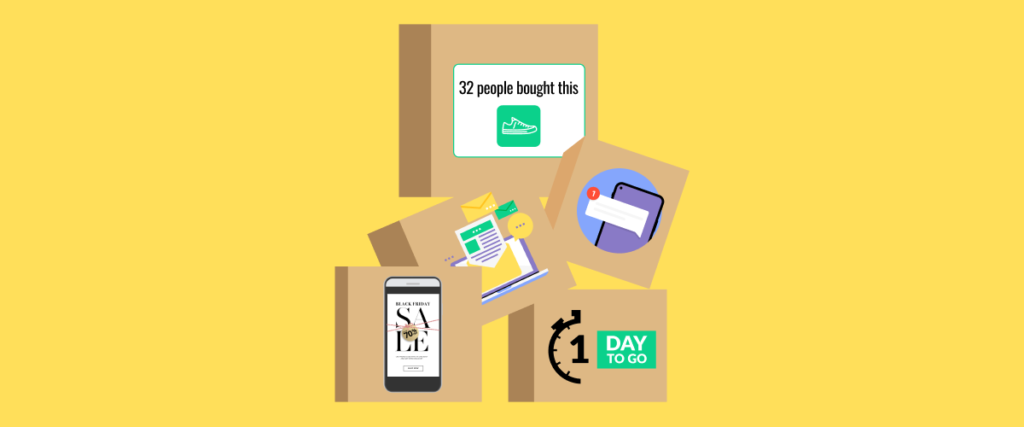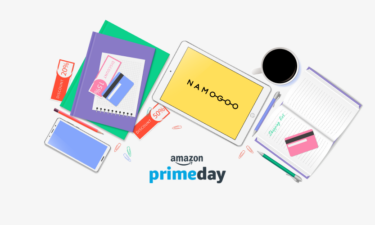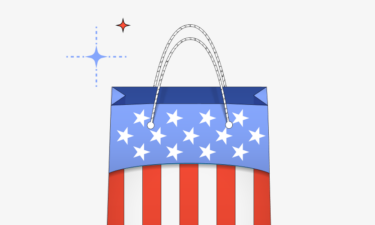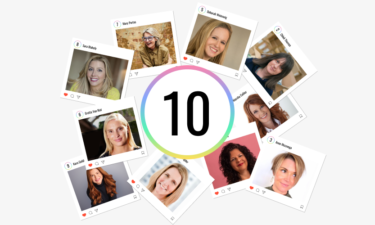Bonus Material: 3 Proven Customer Intent Campaigns for The Best BFCM Yet
The biggest shopping season of the year is just weeks away. Is your eCommerce store ready? According to eMarketer, eCommerce sales for 2021 could exceed $200 billion[*].
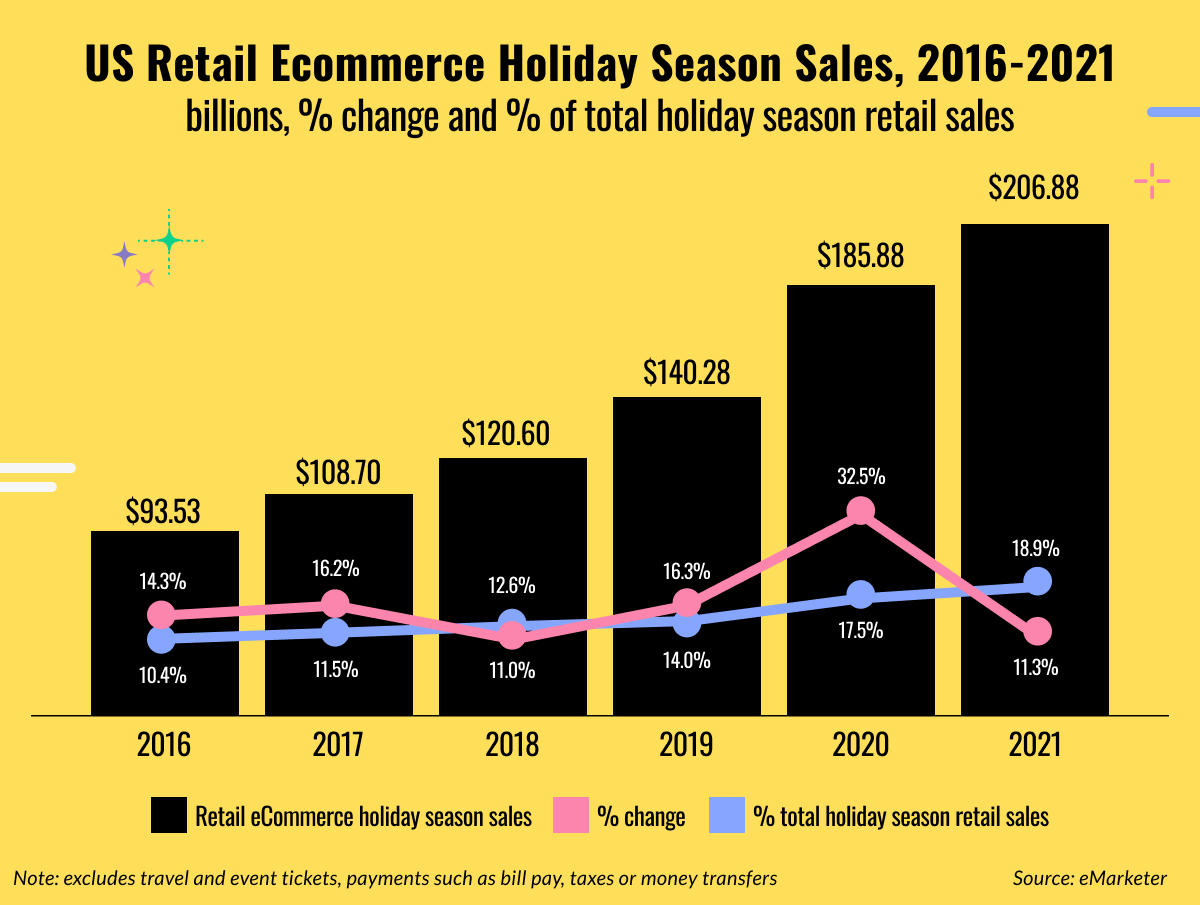
Black Friday sales last year surged 22% YoY; that trend may repeat as COVID cases spike around the globe.
Despite the growth in online shopping, competition continues to expand. There are currently millions of online stores worldwide, which means standing out is crucial to getting a piece of the BFCM pie.
Is your eCommerce store ready to compete? Here are fifteen steps to ensure your eCommerce store is prepared for the Black Friday/Cyber Monday shopping season.
#1. Start Building Your Email List Now
#2. Implement Another Means of Communication with Your Customers
#3. Get Your Audience Excited Ahead Of Time
#4. Rise Above the Clutter & Launch Your Promotion Early
#5. Perform A Traffic Stress Test
#6. Optimize Your Checkout Process
#7. Offer the Right Promotion to Each Customer Based on Intent
#8. Ensure Customer Service is Ready
#9. Create a Holiday Season Section
#10. Create Urgency to Drive More Checkouts
#11. Make Registration Worth It
#12. Launch Dynamic Retargeting Campaigns
#13. Make Your Return Policy Clear & Painless
#14. Turn Holiday Shoppers Into Loyal Customers
#15. Expect The Unexpected
BFCM Success Starts Today
#1. Start Building Your Email List Now
Email marketing attracts eCommerce customers and drums up interest in Black Friday and Cyber Monday sales. Plus, email marketing has an average ROI of 42:1[*]. Building your list now ensures you reach a wider audience — and it helps you compete with the growing number of online stores.
Here are strategies to start building your holiday email list now:
-
- Add popups and bars to collect email addresses: Adding multiple ways for users to sign up can increase subscribers with very little effort.
- Focus on value: Why should users sign up for a list? Do you offer sneak peeks at new sales or launch new products via email? Tell users what is in it for them.
- Offer a small discount for new subscribers: A 10 or 15% discount may encourage new subscribers to join your list.
- Offer members-only benefits: Offer exclusive offers to subscribers to encourage sign-ups, such as a small gift with their first purchase or a loyalty program, like this one:

- Create a waiting list for email subscribers. Prime your visitors and incentivize email subscriptions with a BFCM waitlist for access to cyber weekend promotions.
Launching a unique email capture campaign to build a list of subscribers primed to jump on your Black Friday/Cyber Monday promotions is worthwhile.
#2. Implement Another Means of Communication with Your Customers
By now, all brands are seeing the impact of iOS14 on their digital advertising efforts.
And Apple’s next iOS update will complicate things further for businesses, this time with email marketing. Their implementation of Mail Privacy Protection and Hide My Email within iCloud+ is the next step in user privacy protection.
The full impact of iOS15 on email marketing is unknown, but one thing is for certain: collecting data to determine the success of your email marketing campaigns will become challenging, and this is going down in the fall: right before Black Friday’s shopping event.
eCommerce brands, therefore, are smart to implement alternative means of communicating with their customers and growing audiences. Consider building a database of customers and subscribers through:
- SMS marketing: Though the majority of companies are still not employing this powerful customer communication strategy, SMS marketing messages see higher open, clickthrough, and conversion rates than email marketing.
- Push notifications: Asking your customers to allow for push notifications from your brand can be a powerful mode of communication in conjunction with email and SMS.
- Messenger marketing: 1:1 instant messaging platforms like Facebook Messenger and Whatsapp are effective communication platforms because they connect with users where they’re already having conversations. Messenger marketing also provides that instantaneous feedback loop that customers expect and are used to.
Diversifying your channel mix when it comes to your 1:1 communications with your audience is smart regardless of Apple’s ongoing privacy updates, but it makes it even more urgent now.
Email marketing is not dead due to iOS14, and it’s not going anywhere, so these strategies should be used alongside your email strategy to ensure your messages are reaching your audience.
#3. Get Your Audience Excited Ahead Of Time
When is the best time to start building excitement about BFCM sales?
If you wait until the last half of November, your team will have to compete with the dozens of other brands vying for your target customers’ attention, and your promotion has a high likelihood of being lost in the shuffle.
To stay competitive, sneak peek your Black Friday sale early, either to an engaged segment of loyal customers or to your entire email list as a “reward” for being engaged with your brand.
Tinker Watches does a great job of this by sending a teaser email several weeks before Black Friday:

And the fashion brand Frank and Oak takes it one step further by calling on their customers to add the sale to their calendars so they don’t forget.

Here are some strategies for building buzz for your Cyber Weekend promotion:
- Build excitement on social media about an upcoming email launch of your holiday sales. Bonus: This also increases email sign ups.
- Use popups to promote your upcoming holiday sales and promotions.
- Research which channels your audience spends the most time on, and provide a preview of your sale on those channels. And don’t forget about offline marketing channels like direct mail. Even younger audiences respond to direct mail, with 70% of millennials say they trust direct mail when making a purchase decision[*]
#4. Rise Above the Clutter & Launch Your Promotion Early
That’s how many marketing emails I woke up to on Black Friday in 2020.
That’s 27 separate eCommerce brands vying for my attention via my email inbox before 8am on just one day of the four-day shopping weekend.
That’s not counting the likely hundreds of ads that were served to my social media feeds, search engine result pages, and web browsing sessions over the course of those four days.
While building buzz for your BFCM promotions early is wise, actually launching your Black Friday/Cyber Monday sales promotions 1-2 weeks ahead of time can make all the difference.
Brands that release their promotions early benefit from:
- A relative lack of competition for consumer attention
- The ability to scale back discounts and protect margins as your promotion isn’t being compared to other brands’ sales
- Lower advertising costs including CPC and CPM due to fewer companies entering ad auctions
- More manageable fulfillment and customer service.
Check out how the menswear brand Huckberry released their markdowns a week early:

They say “the early bird gets the worm”, and when it comes to Cyber Weekend, they’re spot on.
#5. Perform A Traffic Stress Test
eCommerce stores see substantial increases in traffic over Cyber Weekend:
- + 197% in 2018
- + 94% in 2019
- + 57% in 2020

And because of the shift in consumer behavior due to the ongoing global pandemic, it’s highly likely that this year will follow suit. Which means you need to ensure your site is prepared to handle the additional traffic.
Nothing ruins an otherwise well-planned promotional campaign like a site that won’t load!
Performing a stress test is the best way to ensure your site can handle traffic spikes. Several tools can help with automated stress tests, including The Grinder (free), Gatling, and Loader.io.
Before performing a stress test, here are a few things to check:
- Check your hosting plan: Shared hosting plans are not ideal. When dozens of sites share the same server, you might not have the resources you need to handle additional traffic. VPS (virtual private servers) or dedicated servers are ideal for high-traffic sites.
- Set up a content delivery network: CDNs, like Cloudflare, deliver files from the server closest to users, which speeds up your site and helps it manage higher traffic.
- Use lazy loading: Lazy loading reduces page weight and conserves bandwidth, which is crucial when traffic is high.
Large spikes in traffic can cause downtime, resulting in reduced sales. Make sure your site is prepared so customers can complete their purchases.
#6. Optimize Your Checkout Process
Few things are more frustrating than a long or confusing checkout process. A poor checkout process results in annoyed users and reduces sales. Now is the time to test and optimize the process.
Here are a few areas to check:
- How is your site speed? Make sure your site doesn’t leave customers hanging when they are ready to checkout. Use Google’s PageSpeed Insights to see how fast your site loads and what improvements are needed.
- How many steps does it take? The longer it takes to check out, the more likely you are to lose customers. Reduce form fields and clicks to streamline the process.
- Don’t require sign-in: Asking users to log in can improve marketing ROI, but it also annoys users. Offer an easy guest checkout option if your site requires registrations.
- Review your payment options: Offering trusted payment options can increase sales. A recent study found people are 54% more likely to buy from online businesses that offer PayPal[*]. Buy Now, Pay Later options are also growing in popularity.
When was the last time you took a look at your checkout process? Now is the time to make sure it is user-friendly, short, and optimized for mobile devices.
#7. Offer the Right Promotion to Each Customer Based on Intent
Between steep blanket discounts, free shipping and fulfillment fees, Black Friday can be tough on eCommerce margins.
But to stay competitive, you recognize that you need to offer enticing promotions over Cyber Weekend to engage, convert, and retain customers.
So one of the best tools in your BFCM toolbox to improve margins while maintaining a strong conversion rate is to capture those pivotal moments of conversion through customer intent.
Some Black Friday shoppers will have high purchase intention without a steep discount, while others are more price-sensitive, especially on black Friday, and they are on the hunt for the best bargain available. These customers may require a more generous offer to complete their order.
Tailoring the offer each visitor is served over Cyber Weekend to their individual intent signals not only drives conversions and revenue, but also protects margins by reducing your average discounting rate.
This is why we built Intent-Based Promotions: to serve a one-to-one customer onsite experience based on shopper intent.
Intent-Based Promotions is a powerful AI tool that calculates shoppers’ purchasing patterns and intent to determine the right offer for each specific customer. And it does so for each session based on behavioral and intent signals:

When you’re crafting your Black Friday sales promotion strategy, you might decide on a maximum discount of 25%, and let the powerful Intent-Based Promotions “brain” decide which customers require that maximum discount to convert, vs. which only require 10, 15, or 20%.
For example, this Namogoo customer set their maximum discount at 15% but averaged only 5.2%.

This helped them save $17,000+ in margin across 117 orders for the week.
Could you imagine what those numbers would look like over Black Friday?
#8. Ensure Customer Service is Ready
Higher traffic means more customer service requests. Is your team ready? Poor customer service can result in lost sales — in fact, 40% of customers say they stop doing business with a company due to poor service[*].
Getting prepared now will ensure your team can handle the inflow of customer service requests promptly. Start by making sure your team is trained and ready to go. Here are a few more ways to make sure
- Add live chat: Live chat is faster and often easier to manage for eCommerce businesses. If you don’t have live chat, now is the time to launch and test before BFCM.
- Update internal documentation: Make sure scripts, troubleshooting checklists, and other documentation is up to date. This ensures customer service reps can solve problems fast.
- Add a FAQ page if you don’t have one: A FAQ page helps customers get the answers they need fast — there’s no need to wait in a long queue when they can find out the average shipping time right on your FAQ page.
- Use automation: Reducing customer service calls allows your team to focus on calls that require a personal touch and lowers operational costs. Consider adding a chatbot or automated email responses to your customer service tool bag. Automation won’t replace humans, but it can help them work more efficiently.
#9. Create a Holiday Season Section
Make it easier for consumers to find the perfect gift or holiday deal by creating a holiday section and highlighting it in your navigation. Namogoo customer Uncommon Goods has a gift section and several subsections, which allows users to shop by recipient, event, and price.

Adding hot deals or popular items to your homepage can help drive more traffic to your most popular collection pages.
Check out how Kylie Cosmetics communicates the weekend’s biggest offers on the homepage:

It’s effective, easy to understand, and employs many smart psychological discount strategies to maximize conversions.
#10. Create Urgency to Drive More Checkouts
The internet is full of distractions, and many consumers are doing their online shopping while also doing other things — like working, talking on the phone, or browsing social media.
So it’s no wonder that 69% of would-be-customers abandon their carts.
One of the most effective strategies to reduce shopping cart abandonment and drive more customers to check out is by creating urgency.
Urgency communicates to the customer that they need to act soon if they intend to convert at all, and reduces the chance that they’ll leave with the intention of returning. And it’s unlikely that they’ll remember to return.
Here are a few ways to create urgency on BFCM:
- Countdown timers. If ever there was a time to implement a countdown timer, it’s during Black Friday. Countdown timers on the cart or checkout page, counting down the time to the sale ending, can provide the push customers need to fulfill their orders.
- Social proof apps. Social proof is an important tool in marketing psychology, and it can be an effective tool in creating urgency. Consider implementing an app like Proof to show users what other visitors are buying.
- Inventory alerts. Many customers add items to their carts but then abandon their checkouts on a regular day; this is amplified over cyber weekend with all of the distraction. Notifying customers of items that are low in inventory can incite urgency and trigger customers to complete their orders in the same session. Check out how Asos does this in the cart:

If you want to really up the ante, employ all three of these strategies for the best cyber weekend ever.
#11. Make Registration Worth It
Requiring users to register has pros and cons.
On one hand, it’s a great way to gather more information about users to improve marketing relevance.
But it can also serve as a stumbling block to conversion… especially on Black Friday, when urgency is at an all-time high and customers lack both the time and patience to sit through a lengthy registration process.
So if your eCommerce store usually requires registration to check out, consider removing this requirement for Cyber Weekend. Make creating an account optional and worthwhile. Incentivize registration through:
- A members-only loyalty program
- Providing personalized product offerings upon account creation
- Unlocking additional discounts or promotions for registered members for the weekend.
Rather than forcing customers to log in from the checkout page, offer benefits for registering and provide a guest checkout option to reduce checkout abandonment and provide a more seamless UX.
You can also offer the option to log in via social media or Google for speed and ease of registration.
#12. Launch Dynamic Retargeting Campaigns
The average conversion rate for eCommerce across all categories is between 1 and 2%[*].
On Black Friday, they average around 4.5%.

This means even if you do everything right, the vast majority of your traffic isn’t going to convert — at least not on the first visit.
Dynamic retargeting campaigns follow users to their favorite sites, like Facebook or Google, and deliver customized ads reminding them to finish their purchase. By showing customers items they are already interested in, you reduce acquisition costs and help to recover abandoned carts.
Starting remarketing campaigns now to target your recent site traffic also helps keep your brand top of mind just before the busiest shopping season of the year.
#13. Make Your Return Policy Clear & Painless
A clear return policy that makes returning or exchanging unwanted items painless gives shoppers a feeling of security and they are more likely to complete a purchase.
They want to know if an item doesn’t fit quite right or if a gift isn’t exactly what a loved one wants, they can return the item with no hassle (or cost.)
Pact, an online retailer for organic clothing, highlights its return policy in the site footer and has a landing page specifically about returns and shipping.

They also mention “free returns” next to product descriptions.

Creating a landing page for your return policy makes it easy to find, but it should also be featured on popular pages, such as your homepage, product page, and checkout page.
Consider adding a pop-up or bar at the top of the site to highlight the policy further.
Offering free returns and including a pre-paid return label in your shipments can make all the difference in the purchase decision process — even if most customers never use it.
#14. Turn Holiday Shoppers Into Loyal Customers
The holiday season is the busiest season for most eCommerce stores — but what happens when the traffic dies down? To make the most of your holiday campaigns, you have to keep those new customers coming back again and again.
Customer retention is the key to long-term eCommerce success. Gaining new customers is expensive; keeping them coming back reduces acquisition costs, improves the ROI of marketing campaigns, and creates a stable source of income.
So how do you turn holiday shoppers into loyal customers? Here are a few strategies:
- Follow up with customers a few weeks after their first purchase. How satisfied are they with the purchase? Is there anything you could have done better? Can you recommend related products?
- Create a drip email campaign: If your new customers signed up for your email list, use the weeks after the holidays to build a relationship. Share what your company stands for, what products you support, and offer educational resources as appropriate. Building brand loyalty can increase sales in the months to come.
- Follow up with personalized product recommendations. Tailoring the customer experience to each shopper communicates that your brand cares about who the customer is as an individual and helps companies to retain those customers. Consider driving repeat purchases through personalized product offerings. Use the customer’s purchase data along with clickstream data to personalize the products you promote, and the offers you send to them. Build custom bundles to introduce them to new products they’d enjoy, and offer complementary products. For example, if your customer bought a pair of running shoes on Black Friday, offer them socks, laces, accessories, or apparel that complements the shoes.
Don’t let all that hard work go to waste! Make sure to keep in touch with new customers and ensure your eCommerce store is top of mind next time they are ready to make a purchase.
Read More: Customer Lifetime Value: What is CLTV, Formula + Why It’s Important
#15. Expect The Unexpected
Preparation is the key to a smooth Black Friday/Cyber Monday. Take time to create contingency plans and prepare for an increase in sales.
Make a list of everything that could go wrong and create a backup plan. If everything goes smoothly, then you won’t have to worry — but if things go wrong, you’ll know just what to do.
Take these steps to ensure your store is ready to deal with any problems that arise>
- Make sure your inventory is well-stocked.
- Review your cyber-security plan and make sure your SSL certificate is up to date.
- Ensure your fulfillment centers or suppliers are prepped for the increased sales. (This is not the time to rely on just-in-time delivery!)
- Have a plan in place for site downtime, low stock, or other challenges. What happens if stock runs out? Will you email people when stock is back, offer a discount on other products, etc.
- Test discount codes, pop-ups, banners, and payment methods on your site.
- Thoroughly QA all apps and third-party software you installed for the weekend.
- Assign a single point of contact for specific issues. Who is in charge if fulfillment has issues or your site has a cybersecurity issue? Empowering one person to make decisions will ensure the problem is solved as quickly as possible.
Cyber Weekend is the biggest shopping event of the year for eCommerce brands, and ensuring your team is prepared for anything will help you to maximize the momentum.
BFCM Success Starts Today
Black Friday and Cyber Monday are no longer one-day sales that require a few days of preparation.
To be successful, your store needs to start preparing now.
Make sure your logistics, marketing campaigns, and customer service team are trained and have the resources they need. Optimize your checkout process and ensure your site can handle the traffic spike so customers can complete their purchases.
Finally, track which strategies work and which ones don’t. Metrics like campaign ROI, website downtime, average order value, and shopping cart abandonment rates will highlight what strategies need to be adjusted for next year.



